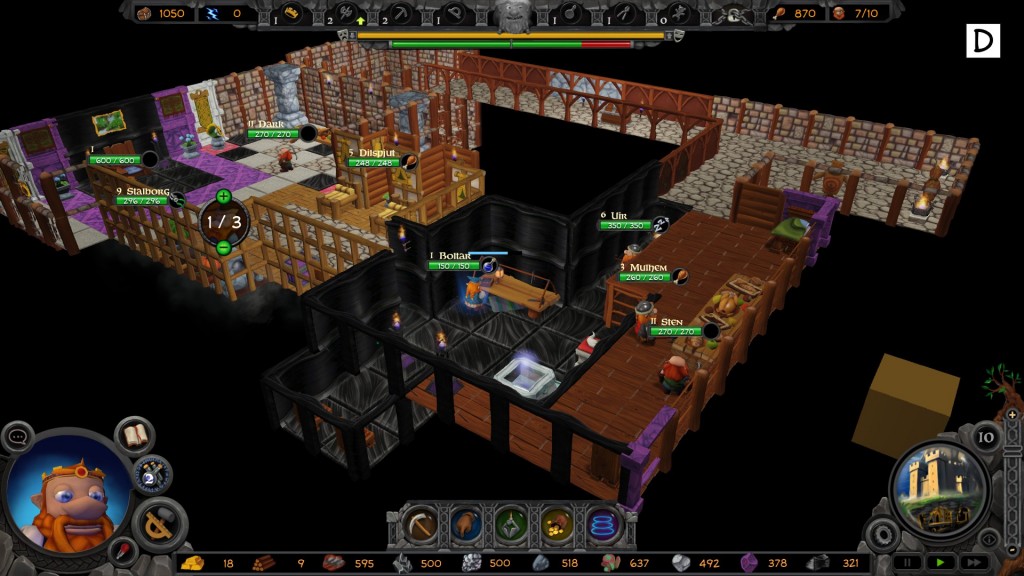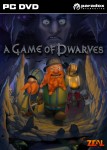Review: A Game of Dwarves (PC)
One may be tempted to compare the new mining-based simulation, A Game of Dwarves, with the currently successful Minecraft game. However, it’s true predecessor (and Minecraft’s as well) is the niche game, Dwarven Therapist. In Dwarven Therapist, one manages a small group of dwarves trying to meet their needs while simultaneously staffing off the occasional crisis like rampaging monsters. A Game of Dwarves is much less complex (and thankfully is much easier to grasp) while also presenting a much more lush and beautiful dungeonscape to explore. Manage a small colony of dwarves who must carve out their domain from the bedrock of a mountain, complete with managing dwarves’ food supplies, contentment, and their need for rest. The game can be played in a campaign mode with successive challenges or in a sandbox mode where a creative player can go wild to carve out their “dream cavern”. As a mix of The Sims, Minecraft, and a role-playing game, A Game of Dwarves serves up a nice bit of exploration, strategy, and creativity.
Within the campaign portion of the game, one plays as a Dwarven Prince hoisted out of his home in order to grow up a little bit. Successive challenges are presented where one must grow a colony from scratch and build it up to complete the main objective – be that digging down to a particular tomb, defending from invaders, gaining specific resources, constructing a required number of items, and similar ilk. Your ultimate goal is to keep the prince safe and sound (even though he never does any “work”) and in the meantime one has to balance the demands of the colony. Additional dwarves are called up from the main settlement and appear as helpless novices, unable to perform any work. They simply take up space and eat the food supply. However, they do passively gain experience at a fairly quick pace. They can then be converted into a specialist dwarf (who do all the work) to take care of specific needs: mining, gathering food, constructing items and furniture, researching new technologies, and protecting against invading monsters. Dwarves do gain experience while working at their tasks, but unspecialized dwarves will always gain experience faster.
Every dwarf has an energy level and a hunger level. If they run out of either they die. Thankfully, when either drops to a low level they will seek out a place to rest (typically a constructed bed or bench nearby) or eat (at a constructed buffet – as long as the colony has sufficient food supply.) To keep the food supply high, workers need to be assigned to harvest plants (planted in special fertile areas in the dungeon). Wood (gathered from plants) and stone (mined from the ground) are needed to construct beds and tables, so some dwarves will need to mine the area looking for stone and other materials (gold, silver, iron, marble, tourmaline, etc… ). Digging deeper into the earth reveals rarer types of ore (for upgraded or simply prettier stuff) but also risks discovering more powerful wandering monsters. Mining has the added benefit of clearing out more space for construction, just remember to keep ladders and stairs in place so that no miner works themselves into a pit from which they can’t escape. (A common early mistake is to mine downward without remembering to add in a ladder in time for the miners to get back up to eat and rest.) Those workers and miners will need a place to sleep so some dwarves need to be assigned to crafting. Crafting extraneous things like paintings, statues, pretty floors, will also improve morale for short periods and thus improve everyones’ performance as well. Occasionally small underground rooms are encountered filled with aggressive beasts and other enemies so its good to have a few well trained warrior dwarves around to take care of them before the enemies hurt the less militaristic dwarves or (heavens!) even the nice furniture. A final type of dwarf is the scholar. While not strictly necessary for a colony’s survival, provide him (they all seem to be male, but it’s hard to tell) with a research table and he will research upgrades for the colony such as improving mining rates, unlocking the ability to build traps for protection, and other overarching benefits.
Control of the game is surprisingly smooth. Dwarves go about their business with surprising efficiency. Workers are assigned areas to collect, while soldiers can be called to an area via a constructed marker. In a pinch, a teleport spell can be used to collect up to 5 dwarves and teleport them instantly to another location. Perhaps the toughest part of the interface to overcome is playing in a fully 3D environment. While this is very “cool” from a graphics perspective, it does have a little learning curve to discover how best to mark areas for digging, locations for crafting, etc… To view fewer levels at a time, simply lower the “level” of the viewpoint and upper levels will be sliced off the top, providing a cleaner view. This can be good or bad – at least until familiarity with the controls is grasped. Hidden areas underground are sometimes marked by little question marks, and since these are not yet connected to one’s tunnel system it can be tricky to ascertain their correct level.
Even within the campaign mode, the game can be played in two ways. One can simply race to complete all the objectives, or go more slowly and build up a “prettier” colony (through decorations and designs, etc…) before finishing off the level. When combined with the sandbox mode, this is a great example of a game that will encourage a child’s creativity. The game is available at retail but also as a fairly inexpensive download. While the campaign mode isn’t particularly long (the individual level layouts are randomized, though) the sandbox mode provides a great long-term opportunity to enjoy the title making this an excellent value for the price.

Kid Factor: This is a pretty great little game for kids who like to construct things. (OK, there is an “Ale Tree” as a special download, but these are dwarves after all…) Most of the quest objectives are communicated in dialogue scenes (almost no voice acting) so reading skill is necessary, but dealing with things in three dimensions also requires a bit of cognitive skill. I’d suspect the game would be a great fit for kids in upper grade school or above. (Or any adults who like to build things and dig in a sandbox looking for new discoveries…)






Discussion Area - Leave a Comment